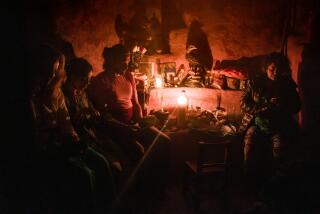Herb Lures Tourists to Mexico for Legal Mind-Bending Trip
HUAUTLA DE JIMENEZ, Mexico — This sweltering corner of the Sierra Mazateca Mountains has seen some unusual visitors lately, thanks to a fern-like plant with thick stems and fluffy leaves.
A British businessman showed up with a sack of pesos, asking to trade them for a sack of leaves. A Spanish importer offered a theater-style TV and satellite service in exchange for three seedlings. A couple from Mexico City spent four days asking questions, learning how to dry the plant’s stems and extract its bitter juice.
All were trying to grab a piece of the small but growing market for Salvia divinorum, a legal hallucinogen that packs a more powerful psychedelic punch than peyote, psyllocybin mushrooms or any other natural hallucinogen.
“More and more people come here and ask to try it. Others ask me how they can grow it,” said Alejandro Martinez, a 24-year-old student who grows more than 700 Salvia plants next to a mountain stream. “I had coffee plants, but now I’m planting Pastora. . . .”
Known to locals as “Maria Pastora,” or “Mary the Shepherdess,” Salvia is a member of the mint family and a distant relative of cooking sage that grows naturally only around Mazatec Indian settlements in this remote corner of Oaxaca state.
Internet sites around the world hawk the herb as “legal ecstasy,” boast of its wild popularity on the streets of New York’s Greenwich Village and encourage would-be buyers to experience a Salvia trip before authorities declare it illegal.
But for dozens of Mazatec healers, Salvia is a powerful and sacred plant with curative powers and frightening mind-altering effects.
“One has to be very delicate with Pastora. It is the most dangerous plant we have,” said Aurelia Catarino Oseguera, a 56-year-old shaman who speaks only Mazatec. “It opens doors in your head that let you see God, and that can be frightening.”
Users say Salvia can produce vivid hallucinations and out-of-body experiences, but can make them feel like inanimate objects and cause short-term memory loss.
Its unpredictable effects make even regular users nervous. One Internet chat room participant warned those trying Salvia to be ready for “the most intense experience humanly possible next to death.”
“This is not a party drug. It’s a drug that takes you to a very deep and introspective place, and that’s not always a fun place to be,” said Daniel Siebert, creator of a Malibu-based Web site devoted to selling and researching Salvia.
“With high doses, its effects happen so fast and are so intense that you don’t have time to really understand what’s going on and you spend your time trying to get back to reality.”
The Mazatecs believe that people who disrespect an animal, a river or any other feature of nature can find themselves cursed with illness. They must seek the advice of a shaman who offers patients psyllocybin mushrooms or Salvia to discover what they did wrong.
Herbal healers say rubbing Salvia on skin can heal burns and make scars disappear. They say wearing the sage on the head for 20 minutes can cure any headache.
“For our ancestors, Pastora was the most important plant there was,” said Arturo Ortiz, a 38-year-old healer whose one-room shack is cluttered with an assortment of pickle jars filled with herbal concoctions for afflictions from foot pain to cardiac arrest. “Its juices have more power to heal than outsiders can understand.”
Since the early 1960s, this scruffy coffee-growing city of 50,000 has been famous in hard-drugging circles, attracting thousands of hippies looking for a shaman to guide them on a magical mushroom trip.
The promise of psychedelic romps brought Bob Dylan, the Rolling Stones and Pete Townsend to Huautla. Locals even swear that the Beatles arrived here by helicopter to celebrate Ringo Starr’s birthday in 1968.
But fresh mushrooms are available only during the rainy season between May and August. Four-foot-high Salvia plants grow year-round.
Catarino has overseen the mushroom trips of hundreds of foreigners inside a fiberglass-roofed barn plastered with statues and pictures of Jesus Christ and the Virgin Mary. She said so many tourists have come asking for Salvia recently that she now refuses to give it out.
“When you die, everyone has to pay for what they did in life,” said Catarino, who still grows Salvia in her garden to treat sick neighbors. “If I give Pastora to people who don’t need it, I will pay for it and be punished when I die.”
Salvia’s burgeoning popularity has spawned a cottage industry of local coffee farmers who grow the plant for export, said Juan Campos, an anthropologist at the National Indigenous Institute.
“There is some evidence that ritual use is declining and that some Mazatecs are growing the plant for sale,” he said, adding that shipping the sage out of the country is legal as long as exporters obtain a permit from Mexico’s forestry service.
Martinez, the student who makes extra money pairing tourists with their desired drug, said he meets five foreigners a week who are looking for Salvia.
“Two years ago nobody wanted Pastora,” he said. “Wait two more years and everyone is going to be like me: They are going to be selling it to lots of people.”
Martinez offers foreigners the eight to 30 Salvia leaves it takes to get high for $5.50.
On Internet sites from Madison, Wis., to Manchester, England, an ounce of 100-200 leaves fetches up to $120.
Martinez said the longer the sage stays legal, the more people will come here looking for it.
“The attitude now is, ‘Why not try it?’ ” he said. “Many of us hope that doesn’t change.”
More to Read
Sign up for The Wild
We’ll help you find the best places to hike, bike and run, as well as the perfect silent spots for meditation and yoga.
You may occasionally receive promotional content from the Los Angeles Times.






